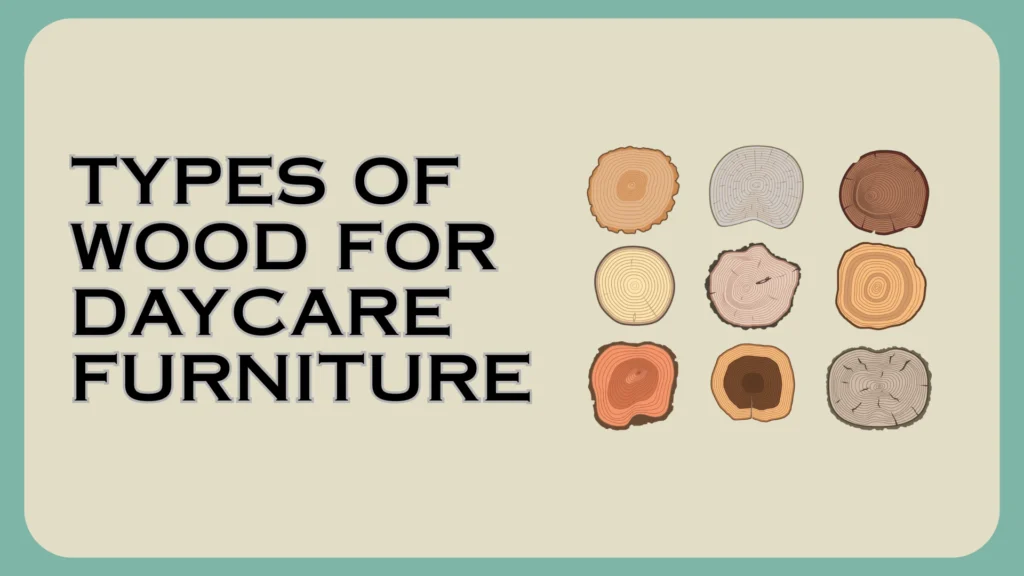When you plan a new kindergarten classroom, it’s easy to focus on colors, shapes, and layouts first. But the types of wood for furniture you choose quietly determine how safe, stable, and durable your classroom will be over the next five to ten years. Children climb, lean, push, and sometimes even chew on furniture; poor-quality wood can wobble, crack, or chip much faster, creating safety risks you cannot ignore.
The wood species behind each chair, table, and shelf also affects how well the furniture stands up to daily cleaning, spills, and humidity. Some woods resist dents and scratches better, some handle moisture without warping, and others are more suitable only for light indoor use. By understanding the main types of wood for furniture used in kindergarten settings, school owners and directors can make informed choices instead of relying only on catalog photos or brand reputation.
There is also a financial and environmental side to this decision. Choosing appropriate wood can reduce the need for frequent replacements, saving budget over time. At the same time, selecting certified, responsibly sourced hardwoods, softwoods, or engineered wood products supports more sustainable early childhood environments. In short, learning about wood is not a technical detail for carpenters only. It is a key part of creating safe, long-lasting, and child-friendly kindergarten spaces.
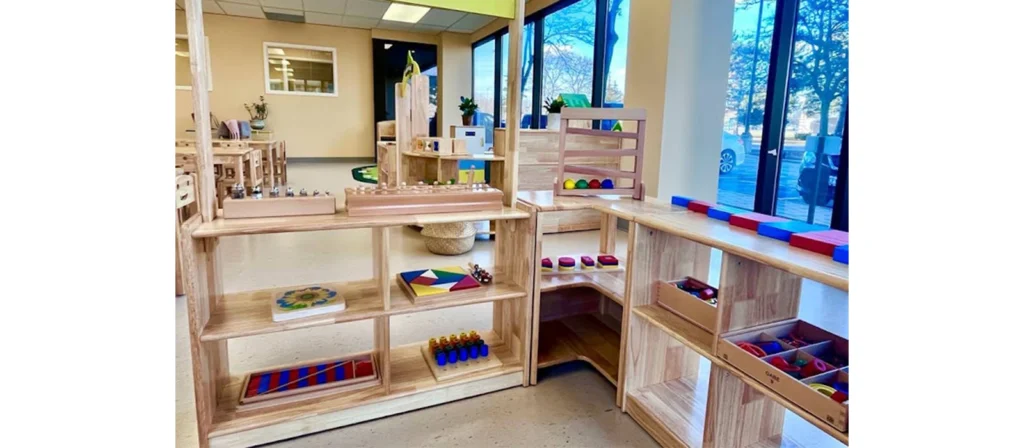
Natural Hardwoods and Softwoods in Kindergarten Furniture
Before exploring individual species, it is helpful to understand the broader categories of hardwoods and softwoods. Each offers unique qualities that influence durability, appearance, maintenance, and usability in kindergarten environments.
Hardwood Furniture
Hardwood furniture is made from slow-growing broad-leaved trees, which naturally produce dense and heavy wood. Most hardwoods have warm or rich colors, from pale cream tones to deep reddish-brown hues. They often carry a mild, natural scent that fades over time and a smooth or finely textured surface depending on the species. Because of their density, hardwoods feel solid to the touch and provide a stable, weighty presence in classroom furniture.
Key characteristics of hardwood furniture include:
- High density and strength: Resistant to scratches, dents, and heavy daily use.
- Excellent durability: Maintains structural stability even in active kindergarten environments.
- Attractive grain patterns: Offers a premium, natural aesthetic suitable for classrooms.
- Better moisture resistance: Less prone to warping or swelling in humid conditions.
- Long service life: Often lasts longer than softwood or engineered materials when properly maintained.
Softwood Furniture
Softwood furniture is made from fast-growing evergreen trees, giving the material a lighter weight and softer overall feel. Softwoods usually come in pale or light yellowish tones, with a clean and gentle visual appearance that suits early childhood environments. Their scent is often more noticeable than hardwoods, especially in species like cedar or pine, and the aroma gradually fades. The surface texture ranges from smooth to slightly resinous depending on the species, and the wood feels noticeably lighter when lifted or moved.
Key characteristics of softwood furniture include:
- Lightweight construction: Easy for teachers to move, rearrange, or clean around.
- Cost-effective material: More affordable due to easier processing and faster tree growth.
- Child-friendly appearance: Soft colors and simple grain patterns create a calm classroom atmosphere.
- Moderate durability: Performs well with proper construction and finishing, suitable for everyday use.
- Good workability: Easy to cut, shape, sand, and repair, allowing flexible furniture design.
- Natural resistance in some species: Woods like cedar offer inherent protection against insects and decay.
Hardwood Types Commonly Used in Kindergarten Furniture
Hardwoods vary widely in appearance, strength, and natural behavior. Understanding the characteristics of each species helps you choose materials that match the safety, durability, and aesthetic needs of a kindergarten environment. Below are widely used hardwoods in preschool and early learning furniture.
Oak Wood
Oak is a dense and durable hardwood commonly used in long-lasting furniture. Its distinctive grain and warm tones make it a visually appealing and reliable material for kindergarten environments where furniture must endure frequent movement, cleaning, and daily use.
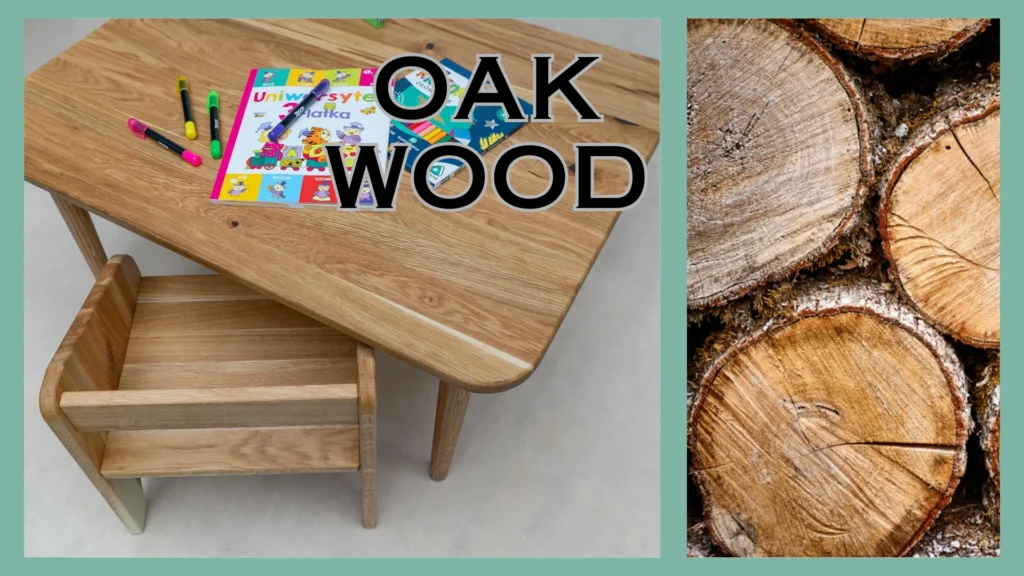
Key Features
- Light to medium brown color with prominent grain.
- Dense and heavy structure offering strong stability.
- Good resistance to wear and impact.
- Mild woody scent that fades over time.
- Suits natural, Montessori-style and Scandinavian classrooms.
Pros and Cons
| Pros | Cons |
|---|---|
| Highly durable and long-lasting | Heavy and difficult to move |
| Excellent resistance to scratches | More expensive than many woods |
| Maintains shape in humid climates | Open grain needs proper sealing |
| Attractive grain enhances aesthetics | Can feel overly heavy in light spaces |
Common Uses in Kindergarten Furniture
- Classroom tables
- Bookshelves and storage units
- Reading corner benches
- Solid wood chairs
- Durable activity stations
Maple Wood
Maple is a strong and fine-grained hardwood known for its clean, bright appearance and excellent resistance to dents. Its smooth surface, pale color, and uniform texture make it especially suitable for modern, Montessori, and minimalist kindergarten environments where light tones and refined finishes are preferred.
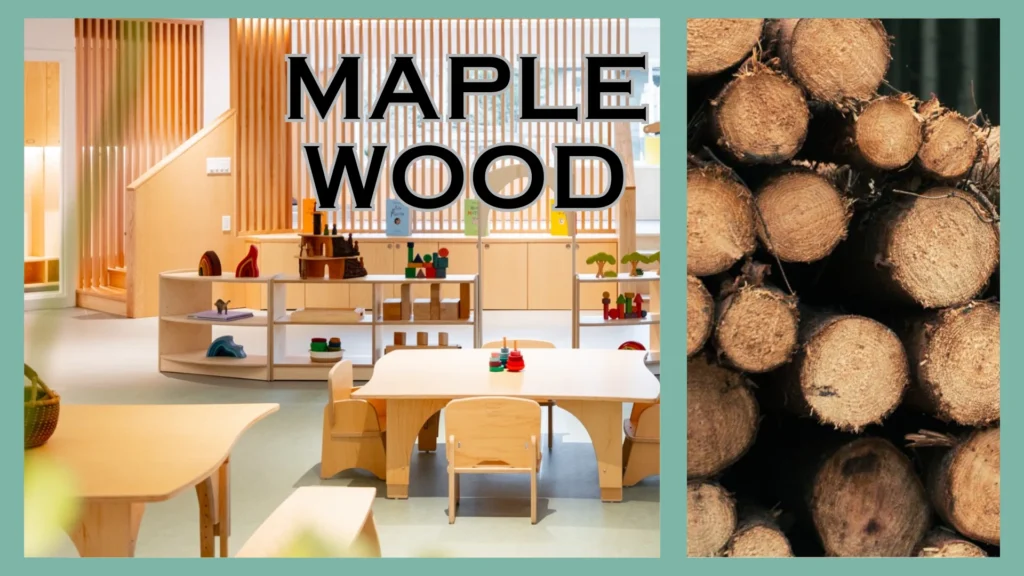
Key Features
- Pale cream to light beige color with subtle, even grain
- Very hard and dense, offering strong resistance to dents
- Smooth, uniform texture ideal for clean, modern designs
- Minimal natural scent and consistent appearance
- Works well in brightly lit or neutral-tone classrooms
Pros and Cons
| Pros | Cons |
|---|---|
| Extremely hard and resistant to dents | Harder to cut and shape during production |
| Smooth and refined appearance | Slightly higher cost than softwoods |
| Holds finishes evenly for a clean look | Can darken slightly over time |
| Stable and reliable in daily classroom use | Less visually “warm” than oak or cherry |
Common Uses in Kindergarten Furniture
- Children’s chairs and tables
- Montessori shelves and trays
- Classroom storage units
- Activity boards and work surfaces
- Practical furniture requiring dent resistance
Iroko Wood (African Teak)
Iroko, often referred to as African teak, is a durable hardwood known for its strong resistance to moisture and natural decay. Its golden to medium brown tone and oily texture make it a practical choice for both indoor and outdoor kindergarten furniture, especially in environments with high humidity or frequent cleaning.
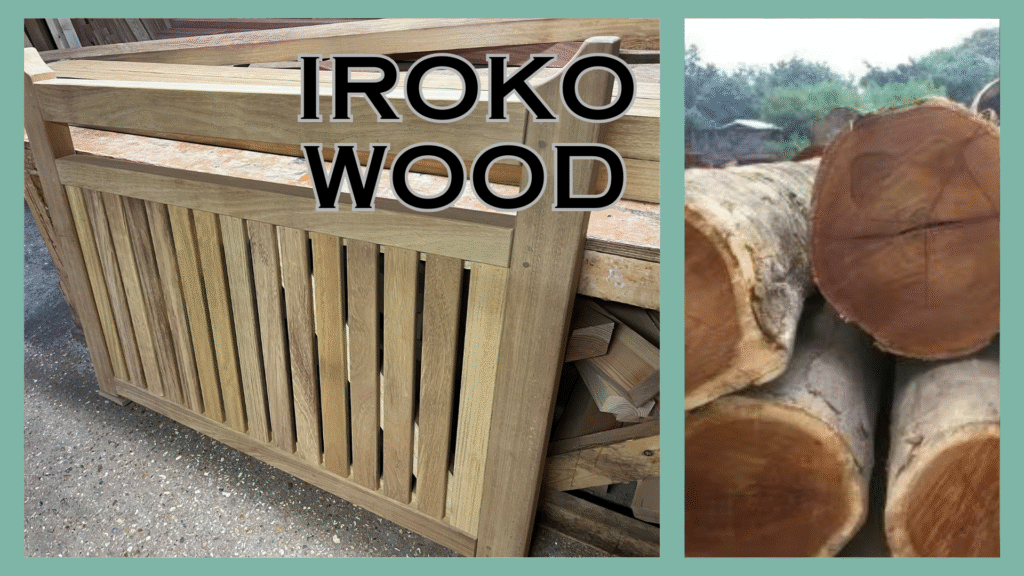
Key Features
- Golden yellow to medium brown color that deepens over time
- Naturally oily texture that improves moisture resistance
- Interlocked grain that adds visual interest and structural strength
- Mild natural scent that becomes faint as the wood cures
- Performs well in humid or high-use classrooms
Pros and Cons
| Pros | Cons |
|---|---|
| Highly resistant to moisture and decay | Grain can be difficult to cut cleanly |
| Excellent durability for indoor and outdoor use | Color variation may require matching |
| Strong stability even in changing climates | Slightly oily surface may affect finishing |
| Long service life with minimal maintenance | More expensive than many softwoods |
Common Uses in Kindergarten Furniture
- Outdoor benches and play structures
- Indoor shelves and storage units in humid climates
- Activity tables requiring moisture resistance
- Water or sensory play furniture
- Long-lasting reading area seating
Beech Wood
Beech is a strong and versatile hardwood widely used in early-childhood furniture due to its smooth texture, fine grain, and excellent bending properties. Its pale cream to light pinkish tone creates a clean and gentle look that fits well in Montessori and Scandinavian-style kindergarten classrooms. Beech is especially valued for its ability to form curved components, making it ideal for ergonomic children’s chairs.

Key Features
- Pale cream to light pink color with a fine, uniform grain
- Smooth texture suitable for soft-touch, child-friendly finishes
- Good bending strength, ideal for curved or molded furniture
- Mild natural scent and consistent appearance across pieces
- Stable performance with proper sealing in indoor environments
Pros and Cons
| Pros | Cons |
|---|---|
| Strong and resilient for everyday use | Can swell in high humidity if unfinished |
| Excellent for bentwood chair designs | Heavier than some hardwoods |
| Smooth grain ideal for child-safe finishes | Requires proper sealing to prevent moisture issues |
| Affordable compared to many premium hardwoods | Color may darken slightly with age |
Common Uses in Kindergarten Furniture
- Bentwood preschool chairs
- Tables and work surfaces
- Open shelves and classroom storage units
- Playroom benches and reading seats
- Practical activity furniture requiring smooth finishes
Walnut Wood
Walnut is a premium hardwood known for its rich, dark tones and elegant grain patterns. It brings a warm, sophisticated look to kindergarten spaces that value natural beauty and high-quality finishes. While slightly softer than some dense hardwoods, walnut remains stable, durable, and visually striking, making it suitable for feature furniture pieces that support a calm, inviting learning environment.
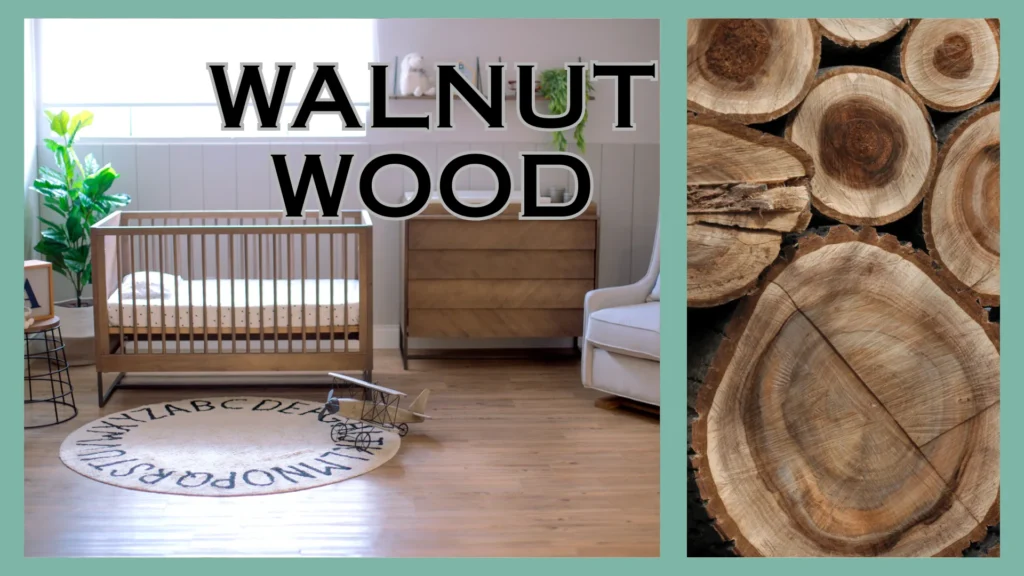
Key Features
- Deep chocolate to medium brown color, often with purple or gray undertones
- Smooth, straight-to-wavy grain that gives a luxurious, high-end appearance
- Medium weight with good dimensional stability
- Minimal natural scent, becoming odorless as it dries
- Strong aesthetic presence ideal for calming, nature-inspired classroom design
Pros and Cons
| Pros | Cons |
|---|---|
| Beautiful grain and premium appearance | Higher cost compared with many hardwoods |
| Stable and resistant to warping | Slightly softer than maple or oak |
| Ages well, developing a deeper patina | Dark color shows dust or scratches more easily |
| Easy to finish with smooth, consistent results | Less common in budget-friendly classroom furniture |
Common Uses in Kindergarten Furniture
- Premium reading nooks or display shelves
- High-end classroom storage units
- Feature furniture in reception or parent areas
- Small tables or activity pieces where aesthetics matter
- Decorative elements or trim in Montessori environments
Ash Wood
Ash is a strong and flexible hardwood known for its light color and pronounced grain. It offers an excellent balance between durability and visual warmth, making it well-suited for kindergarten environments that require sturdy furniture with a bright, welcoming appearance. Ash’s natural shock resistance also makes it ideal for pieces exposed to frequent movement and active use.
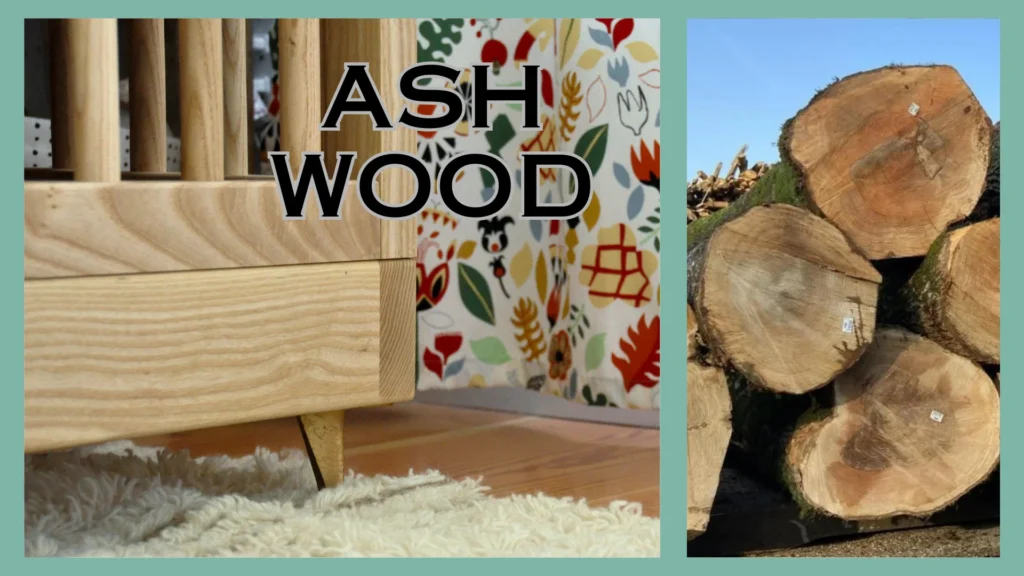
Key Features
- Light beige to pale brown color with bold, straight grain
- Strong and tough with excellent shock resistance
- Medium weight, providing both stability and manageable handling
- Smooth texture suitable for natural or clear finishes
- Works well in bright, minimalist, or nature-inspired classrooms
Pros and Cons
| Pros | Cons |
|---|---|
| High strength and shock resistance | Grain can appear too bold for some styles |
| Durable for daily classroom use | Slightly less moisture-resistant than oak |
| Light color brightens learning spaces | Requires proper sealing to prevent discoloration |
| Good workability for various furniture styles | Can darken slightly over long-term exposure |
Common Uses in Kindergarten Furniture
- Classroom tables and chairs
- Bookshelves and storage units
- Playroom benches and seating
- Activity stations requiring high durability
- Montessori-style open shelves
Cherry Wood
Cherry is a refined hardwood known for its warm color tones and smooth, elegant grain. It starts with a light pinkish-brown hue and gradually develops into a deep, rich reddish-brown as it ages. Cherry offers dependable strength and a soft visual appeal, making it suitable for kindergarten spaces aiming for a warm, inviting atmosphere without sacrificing durability.
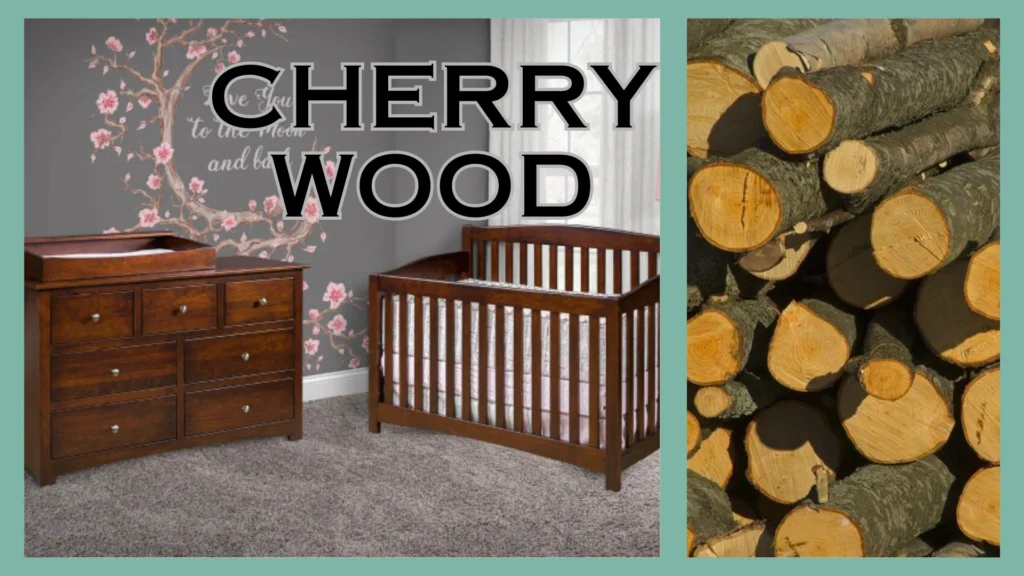
Key Features
- Light pinkish brown that deepens to a rich reddish tone over time
- Fine, smooth grain with a subtle, even texture
- Medium density providing stable structural performance
- Mild natural scent that fades as the wood dries
- Ideal for warm, cozy classroom designs or reading corners
Pros and Cons
| Pros | Cons |
|---|---|
| Beautiful color that improves with age | Higher cost than softwoods and some hardwoods |
| Smooth texture ideal for child-friendly finishes | Slightly softer than maple or oak |
| Good stability and workability | Sensitive to direct sunlight during aging |
| Creates a warm, soothing classroom atmosphere | Color variation may require careful selection |
Common Uses in Kindergarten Furniture
- Reading corner furniture and small benches
- Warm-toned storage units
- Decorative shelving and display areas
- Tables with refined finishes
- Feature furniture in parent or reception zones
Balau Wood (Red Balau / Ironwood)
Balau is an exceptionally dense and heavy tropical hardwood commonly referred to as ironwood due to its remarkable strength and durability. It ranges from reddish-brown to deep brown and contains natural oils that improve resistance to moisture, insects, and decay. These properties make Balau highly suitable for kindergarten environments that require long-lasting outdoor furniture or high-stress structural components.

Key Features
- Reddish to deep brown color with a coarse, interlocked grain
- Extremely dense and heavy, offering superior strength
- High natural oil content that boosts weather and insect resistance
- Coarse texture requiring skilled finishing
- Ideal for outdoor or high-moisture kindergarten environments
Pros and Cons
| Pros | Cons |
|---|---|
| Outstanding durability and load-bearing strength | Very heavy and difficult to move |
| Excellent moisture, insect, and decay resistance | Harder to cut, sand, and machine |
| Long lifespan in outdoor environments | Can be expensive due to density and transport weight |
| Ideal for outdoor structures in kindergartens | Coarse grain requires careful finishing |
Common Uses in Kindergarten Furniture
- Outdoor play structures and climbing frames
- Garden benches and durable seating
- Outdoor decks or platform areas
- Water-play structures requiring moisture resistance
- Exterior tables or activity stations
Accoya Wood
Accoya is a high-performance modified wood produced through acetylation, a process that significantly enhances the durability, stability, and moisture resistance of sustainably sourced softwood. With its pale, uniform appearance and exceptional dimensional stability, Accoya performs better than many natural hardwoods, making it an excellent choice for kindergarten environments that face humidity, frequent cleaning, or outdoor exposure.
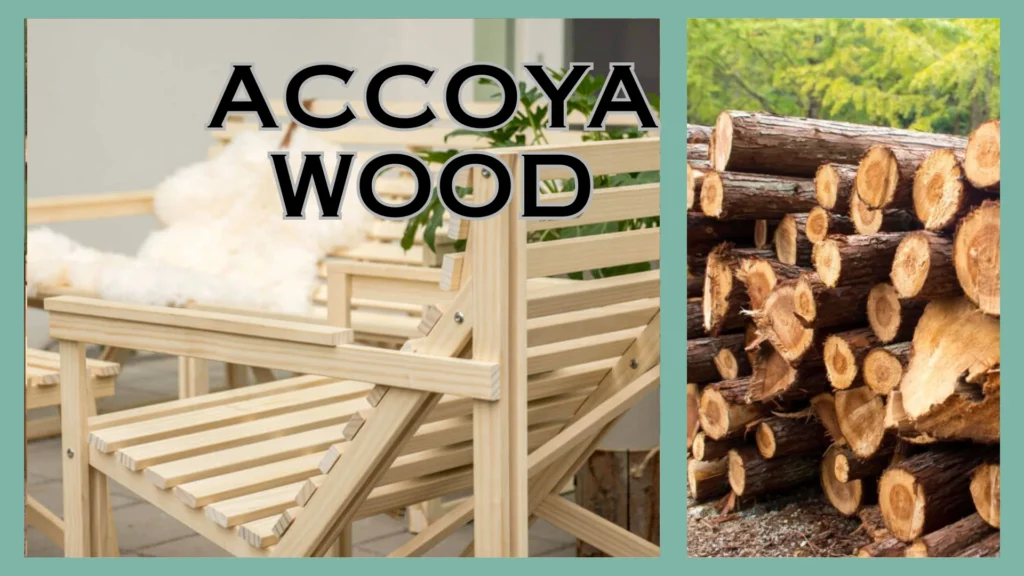
Key Features
- Pale, uniform color suitable for both natural and painted finishes
- Exceptional stability with minimal swelling or shrinking
- Outstanding resistance to moisture, rot, and biological decay
- Smooth texture with consistent grain across panels
- Performs reliably in high-humidity or outdoor classroom settings
Pros and Cons
| Pros | Cons |
|---|---|
| Superior moisture and decay resistance | Higher cost than many natural softwoods |
| Extremely stable with minimal warping | Limited natural grain character compared with hardwoods |
| Long lifespan even in outdoor conditions | Requires certified suppliers due to specialized production |
| Lightweight yet durable | Less common in budget kindergarten furniture |
Common Uses in Kindergarten Furniture
- Outdoor benches, tables, and seating
- Water-play furniture or wet-area structures
- Window frames and doors in learning environments
- Durable exterior panels or screens
- Outdoor storage units and activity stations
Ayan Wood (Afara / Yellow Balau)
Ayan, also known as Afara or Yellow Balau, is a moderately heavy hardwood valued for its balanced performance and affordability. It ranges from pale yellow to light brown and features a straight or slightly interlocked grain. Ayan offers dependable strength and stability without the high cost of premium hardwoods, making it a practical choice for kindergarten furniture that requires durability, moderate weight, and a natural appearance.

Key Features
- Pale yellow to light brown color with a clean, natural look
- Straight to slightly interlocked grain, offering subtle visual texture
- Moderate density providing stable structural performance
- Mild scent that disappears after proper drying
- Fits well in natural-themed or neutral kindergarten environments
Pros and Cons
| Pros | Cons |
|---|---|
| Good balance between strength and cost | Less moisture-resistant than Accoya or Iroko |
| Moderately heavy, providing stable furniture | Grain variation may require selection for uniformity |
| Easy to machine, sand, and finish | Needs proper sealing for long-term durability |
| Affordable compared with many hardwoods | Not ideal for heavy outdoor exposure without treatment |
Common Uses in Kindergarten Furniture
- Classroom tables and chairs
- Standard bookshelves and storage units
- Indoor benches and reading corner seating
- General-purpose activity furniture
- Frames and structural components requiring moderate strength
Softwood Types Commonly Used in Kindergarten Furniture
Pine Wood
Pine is one of the most commonly used softwoods in kindergarten furniture due to its affordability, light weight, and warm natural appearance. Its soft tones and friendly look help create a calm and inviting classroom environment. Pine is easy to machine and finish, making it suitable for a wide range of indoor furniture that does not require heavy structural load.

Key Features
- Light yellow to pale cream color with visible knots
- Lightweight and easy to move for flexible classroom layouts
- Soft texture, easy to sand and finish
- Mild resin scent that fades with time
- Ideal for natural, bright, child-friendly interiors
Pros and Cons
| Pros | Cons |
|---|---|
| Affordable and widely available | Softer surface dents and scratches easily |
| Lightweight and easy to move | Knots may affect stability or appearance |
| Easy to machine and repair | Less durable than hardwoods |
| Warm, natural aesthetic | Requires sealing to prevent moisture absorption |
Common Uses in Kindergarten Furniture
- Lightweight tables and chairs
- Bookshelves and cubbies
- Craft and art storage
- Classroom partitions
- General indoor furniture for younger children
Douglas Fir
Douglas Fir is a strong softwood with excellent structural stability. Although lighter than hardwoods, it offers impressive strength and resistance to bending, making it a reliable material for classroom furniture that must endure frequent use. Its warm reddish-yellow tone suits nature-inspired learning environments.

Key Features
- Pale yellow to reddish-brown color with straight grain
- Strong and firm despite being a softwood
- Good dimensional stability for indoor use
- Slight resinous scent when freshly cut
- Fits natural or rustic classroom aesthetic
Pros and Cons
| Pros | Cons |
|---|---|
| Stronger than many softwoods | Surface may show wear over long use |
| Good resistance to bending and pressure | Less moisture-resistant than cedar |
| Affordable alternative to hardwoods | Grain can splinter without sanding |
| Attractive natural tone | Needs regular sealing for longevity |
Common Uses in Kindergarten Furniture
- Classroom chair and table frames
- Shelving systems
- Indoor play structures
- Storage cabinets
- Activity stations needing moderate load capacity
Cedar Wood
Cedar is a naturally aromatic softwood known for its excellent resistance to insects, decay, and moisture. Its warm reddish tones and pleasant scent make it appealing in kindergarten environments, particularly in regions with high humidity or areas requiring furniture with natural moisture management.

Key Features
- Warm reddish to light brown color with fine grain
- Natural aromatic scent that is calming and insect-repellent
- High resistance to moisture and decay
- Lightweight and easy to move
- Suitable for humid or semi-outdoor learning spaces
Pros and Cons
| Pros | Cons |
|---|---|
| Resists insects and natural decay | Softer surface dents easily |
| Pleasant scent enhances environment | More costly than pine |
| Stable in humid climates | Not suitable for heavy structural use |
| Lightweight and easy to work with | Color may fade in strong sunlight |
Common Uses in Kindergarten Furniture
- Semi-outdoor or covered play furniture
- Storage units in humid regions
- Water/sensory play furniture
- Light benches and cubbies
- Decorative classroom elements
Hemlock Wood
Hemlock is a versatile softwood valued for its straight grain, moderate hardness, and clean appearance. It provides a balance of strength and affordability, making it a practical option for many indoor kindergarten furniture pieces where weight, cost, and stability all matter.
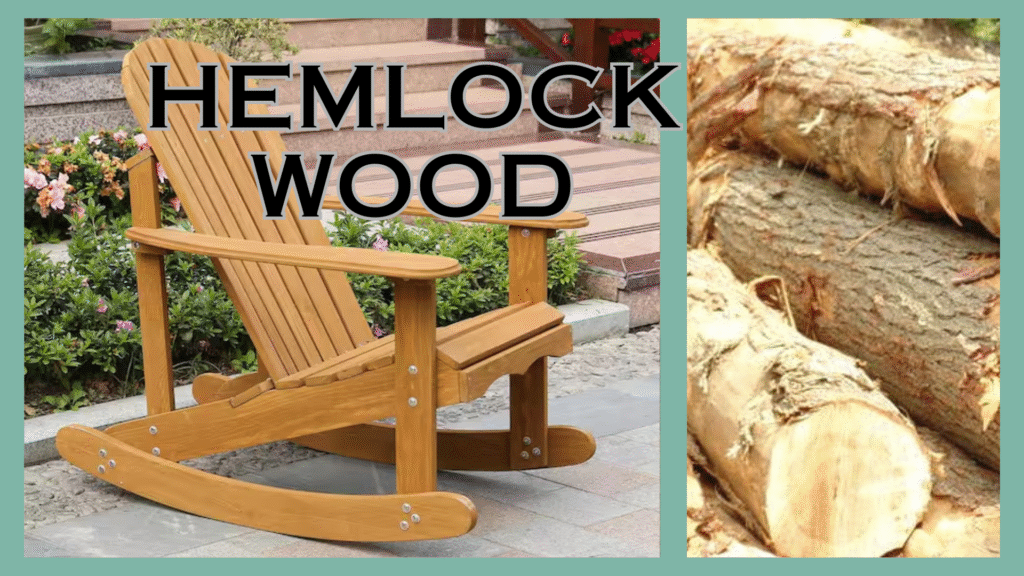
Key Features
- Pale brown to straw-colored wood with straight, uniform grain
- Moderate hardness compared to other softwoods
- Good workability for shaping and finishing
- Minimal scent and consistent appearance
- Fits minimalist or modern classroom design
Pros and Cons
| Pros | Cons |
|---|---|
| Reliable strength for indoor furniture | Less moisture-resistant than cedar or larch |
| Smooth, uniform texture | Needs sealing to prevent wear |
| Cost-effective and easy to machine | Can show dents under heavy use |
| Lightweight and stable | Not suitable for outdoor exposure |
Common Uses in Kindergarten Furniture
- Shelves and cubbies
- Classroom benches
- Indoor play furniture
- Lightweight tables
- Organizational units and storage
Larch Wood
Larch is one of the strongest softwoods available, known for its durability and natural resistance to moisture. Its golden tones and distinct grain create a warm and lively look, making it suitable for high-use kindergarten environments that require both strength and visual appeal.
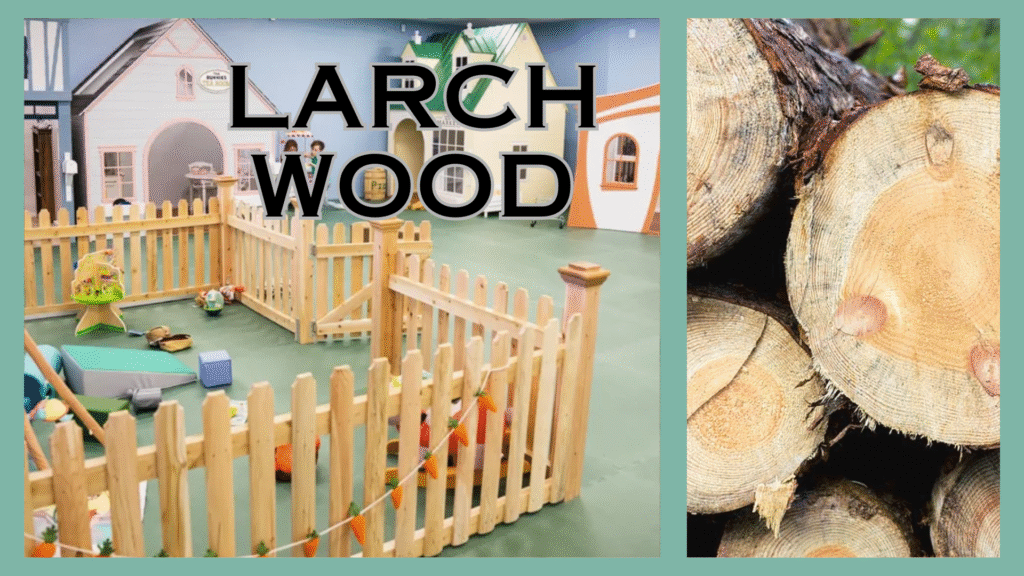
Key Features
- Golden yellow to reddish-brown color with prominent grain
- Harder and more durable than most softwoods
- Naturally resistant to moisture
- Dense texture with noticeable growth rings
- Works well in active indoor learning areas
Pros and Cons
| Pros | Cons |
|---|---|
| Strong and durable for high-use furniture | Heavier than cedar and pine |
| Good natural moisture resistance | Grain can be difficult to sand smooth |
| Attractive grain with warm tones | Less available in some regions |
| Longer lifespan than typical softwoods | Needs finishing for long-term stability |
Common Uses in Kindergarten Furniture
- Sturdy classroom tables
- Activity furniture requiring strength
- Bookshelves and storage units
- Indoor play structures
- Benches and seating
Engineered Wood Types Used in Kindergarten Furniture
Birch Plywood
Birch plywood is one of the most widely used engineered materials in high-quality kindergarten furniture. Made by layering thin sheets of birch veneer under heat and pressure, it delivers impressive strength, stability, and resistance to warping. Its smooth surface and clean appearance make it ideal for Montessori and modern classroom designs.
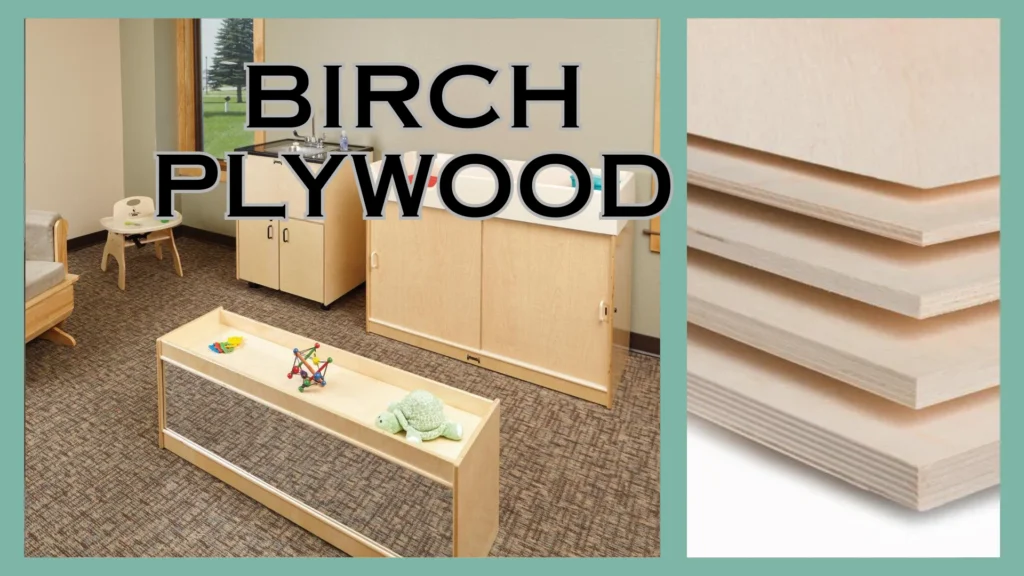
Key Features
- Light cream color with fine, consistent grain
- Strong cross-layer construction for high stability
- Smooth surface suitable for natural or laminated finishes
- Lightweight compared with solid hardwood
- Highly resistant to warping and cracking
Pros and Cons
| Pros | Cons |
|---|---|
| Strong and dimensionally stable | Exposed edges need sealing |
| Lightweight and easy to handle | More expensive than MDF |
| Smooth and child-safe surface | Visible layers may affect look in some designs |
| Resists warping and temperature changes | Requires high-quality veneer for best results |
Common Uses in Kindergarten Furniture
- Montessori shelves and trays
- Storage cabinets and cubbies
- Classroom tables
- Wooden toys and learning materials
- Multi-layered structural furniture
MDF (Medium Density Fiberboard)
MDF is a uniform engineered wood made from wood fibers and resin compressed under high pressure. Its smooth, consistent surface makes it an excellent substrate for painted furniture. Although not as strong as plywood, MDF offers excellent workability and affordability, making it suitable for low-stress kindergarten applications.
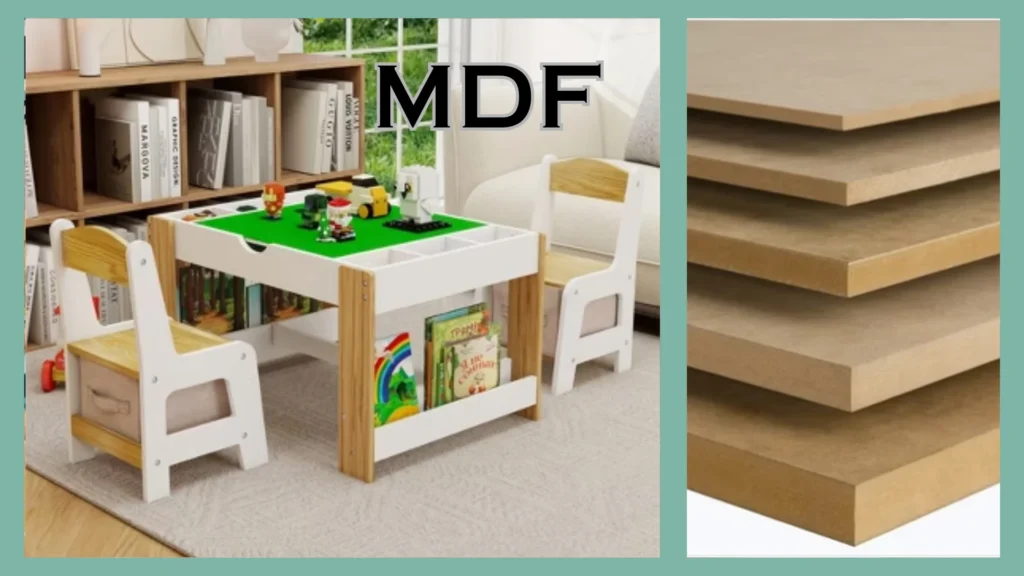
Key Features
- Smooth, uniform surface without visible grain
- Easy to cut, paint, and shape into custom designs
- Consistent density across the board
- Neutral appearance suitable for various finishes
- Best for indoor applications only
Pros and Cons
| Pros | Cons |
|---|---|
| Very smooth for painted finishes | Poor moisture resistance |
| Affordable and easy to machine | Less strong than plywood |
| Great for detailed shapes and curves | Heavy compared to plywood |
| Uniform surface with no knots | Can chip if screws are overtightened |
Common Uses in Kindergarten Furniture
- Painted shelves and cubbies
- Wall panels or room dividers
- Lightweight cabinets
- Craft storage units
- Decorative elements and shapes
Laminated Board (Melamine / Laminate Panels)
Laminated boards are engineered panels coated with a durable melamine or laminate layer, providing a wear-resistant and easy-to-clean surface. They come in various colors and textures, making them popular for modern kindergarten classrooms that require bright, practical furniture with low maintenance.

Key Features
- Wide range of colors, patterns, and textures
- Hard, scratch-resistant surface layer
- Easy to clean and maintain
- Uniform core made of particleboard or MDF
- Cost-effective solution for large-scale furniture
Pros and Cons
| Pros | Cons |
|---|---|
| Affordable with many design options | Less durable than solid wood or plywood |
| Highly resistant to stains and scratches | Edges can chip without proper banding |
| Easy to clean during daily classroom use | Not suitable for heavy structural loads |
| Excellent for colorful classroom themes | Limited repairability once damaged |
Common Uses in Kindergarten Furniture
- Classroom storage cabinets
- Cubbies and locker units
- Colorful tables and shelves
- Art and craft storage solutions
- Easy-clean surfaces for daily use
Comparing Different Wood Types to Meet Kindergarten Furniture Needs
Choosing the right wood for kindergarten furniture depends on where and how it will be used. Indoor environments require materials that are smooth, stable, and child-safe. Outdoor areas demand weather resistance, durability, and structural strength. The tables below highlight the best wood options for each setting, along with their key advantages and typical applications.
Best Wood Types for Indoor Kindergarten Furniture
| Wood Type | Key Benefits | Best Uses |
|---|---|---|
| Maple | Very hard, dent-resistant, smooth grain, child-safe, clean appearance | Tables, chairs, shelves, activity surfaces |
| Beech | Strong bending strength, splinter-free, stable and long-lasting | Chairs, benches, frames, storage |
| Birch Plywood | High stability, lightweight, smooth surface for finishing | Shelves, trays, cubbies, cabinets |
| Ash | Shock-resistant, bright tone, strong and durable | Tables, chairs, benches, activity stations |
| Pine (Budget) | Lightweight, warm color, cost-effective | Shelves, craft tables, partitions, cubbies |
Best Wood Types for Outdoor Kindergarten Furniture
| Wood Type | Key Benefits | Best Uses |
|---|---|---|
| Balau (Ironwood) | Extremely dense, weather-, insect-, and decay-resistant | Climbing structures, decks, outdoor benches |
| Accoya | High moisture resistance, dimensionally stable, durable under exposure | Outdoor seating, water-play furniture |
| Iroko (African Teak) | Naturally oily, resists moisture/decay, great in humid conditions | Outdoor benches, structures, open activity zones |
| Cedar | Insect- and decay-resistant, lightweight, aromatic | Semi-outdoor benches, storage, play structures |
| Larch | Strong softwood, moisture-resistant, warm tone | Semi-outdoor tables, benches, storage, stations |
Each wood type brings unique strengths to learning environments. By matching the right material to the right setting, you ensure safety, durability, and long-term value in your kindergarten furniture. Whether you’re designing cozy indoor spaces or durable outdoor classrooms, thoughtful wood selection helps support both child comfort and educational quality.
Common Misconceptions About Wood Types Used in Kindergarten Furniture
When choosing wood for kindergarten furniture, it is easy to rely on assumptions—many of which are outdated or inaccurate. Misunderstanding wood behavior can lead to poor purchasing decisions, unnecessary costs, or mismatched materials. The following points clarify the most common misconceptions and provide practical guidance based on how wood actually performs in early-learning environments.
Misconception 1: “Hardwood is always better than softwood.”
Hardwood and softwood categories do not strictly determine quality. While hardwoods are generally denser and more durable, many softwoods provide excellent performance for indoor kindergarten furniture.
Why this is incorrect:
- Some softwoods (like Cedar and Larch) naturally resist moisture better than several hardwoods.
- Hardwoods vary widely—Maple is extremely hard, but Cherry is softer than some softwoods.
- Softwoods like Pine and Hemlock are lighter and easier to move, which is beneficial in flexible classrooms.
Correct understanding:
Match the wood to the intended use, not the category.
- Heavy-use items: Maple, Beech, Ash
- Lightweight or budget items: Pine, Hemlock
- Humid areas: Cedar, Accoya, Iroko
Misconception 2: “Engineered wood is lower quality than solid wood.”
Many assume plywood or laminated boards are inferior to solid wood, but this overlooks how engineered materials are designed and used in real classrooms.
Why this is incorrect:
- High-quality birch plywood is more stable than many solid woods.
- Engineered wood resists warping and cracking better in large furniture panels.
- Some engineered boards offer superior cleaning and hygiene performance.
Correct understanding:
Engineered wood is essential in early-learning environments that require:
- warp-free shelves
- lightweight, uniform panels
- smooth, child-safe surfaces
- cost-effective large furniture pieces
Find High-Quality Preschool Furniture Built for Real Classrooms
Choosing the right wood is only the first step. At TOP Montessoris, we provide safe, durable, and thoughtfully designed preschool furniture that matches Montessori and early-learning standards. Explore child-safe tables, chairs, shelving, and activity units made from reliable indoor and outdoor wood materials—crafted to support active learning and long-term classroom use.
 Browse Preschool Furniture
Browse Preschool Furniture
Misconception 3: “Darker wood is always stronger than lighter wood.”
Color has no correlation with strength. A wood’s density, fiber structure, and moisture resistance determine durability—not its shade.
Why this is incorrect:
- Walnut is dark but softer than Maple or Beech.
- Ash and Birch are light-colored yet very strong.
- Many dark-toned woods simply appear “harder” because of their finish.
Correct understanding:
Evaluate wood by its mechanical properties, not its appearance.
- Hardness
- Stability
- Shock resistance
- Moisture tolerance
Misconception 4: “Outdoor wood can be used indoors, and indoor wood can be used outdoors.”
Furniture designed for outdoor use does not always function well indoors, and vice versa.
Why this is incorrect:
- Woods with high oil content (Iroko, Balau) may feel too heavy or coarse for indoor classrooms.
- Indoor woods like Maple or Beech can warp or discolor outdoors.
- Engineered boards such as MDF cannot tolerate moisture for outdoor use.
Correct understanding:
Use wood in environments where it performs best:
- Outdoor: Balau, Accoya, Iroko, Cedar
- Indoor: Maple, Beech, Ash, Birch Plywood
Misconception 5: “All wood behaves the same under humidity.”
Different wood species respond very differently to humidity changes, and this directly affects kindergarten furniture safety.
Why this is incorrect:
- Some woods shrink significantly when dry but swell heavily when humid.
- Poorly chosen wood can cause wobbling, cracking, and joint failure.
- Engineered materials greatly reduce humidity-induced movement.
Correct understanding:
For humid climates or frequent cleaning:
- Choose dimensionally stable woods such as Accoya, Iroko, Birch Plywood.
- Avoid materials like MDF or low-density solid woods in moisture-prone areas.
Practical Tips for Choosing Kindergarten Furniture
Choosing kindergarten furniture involves more than liking how a wood looks. The quality, stability, and safety of wood directly affect how furniture performs in a classroom filled with active children. The following practical tips help you evaluate materials, verify quality, and make confident decisions when purchasing wooden furniture for early-learning environments.
How to Examine Wood Quality in Kindergarten Furniture
Inspecting kindergarten furniture in person or reviewing clear photos and specifications helps you understand whether the wood is durable, safe, and appropriate for classroom use. The following points explain what to look for when examining overall wood quality.
Surface Consistency
- Surfaces should be smooth and even without rough spots or splinters
- High-quality hardwood or birch plywood should feel consistently smooth
- There should be no raised grain, sanding marks, or unfinished areas
Grain Pattern and Direction
- Straight and consistent grain indicates stable, well-selected timber
- Boards with irregular or distorted grain may be more likely to warp
- Natural grain variation is acceptable as long as it does not affect stability
Joinery Quality
- Tight and accurately fitted joints reflect good craftsmanship
- Loose or shifting joints may indicate improper drying or weak materials
- Reinforced joints are important for furniture used daily by children
Signs of Proper Drying
- Wood should not feel damp or unusually lightweight
- Balanced moisture content is essential for indoor furniture, typically between 6 and 10 percent
- Poorly dried wood may crack, shrink, or warp over time
Finish and Coating
- All coatings should be child-safe, non-toxic, and evenly applied
- Corners and edges should be smooth and rounded for safety
- The finish should appear clean and consistent without bubbles, drips, or uneven color
Create Safe and Inspiring Learning Spaces for Young Children
Well-designed preschool furniture supports independence, improves classroom flow, and enhances daily learning. Discover durable, child-safe furniture crafted from reliable wood materials—perfect for Montessori, Reggio, and early-learning environments. Build classrooms that are organized, developmentally appropriate, and ready for active learners.
 View Preschool Furniture Collections
View Preschool Furniture Collections
How to Distinguish Solid Wood from Engineered Wood
Kindergarten furniture may use both solid wood and engineered wood. Understanding how to identify each material helps ensure better purchasing decisions, especially regarding durability, stability, and long-term value.
How to Identify Solid Wood
Solid wood comes from a single piece of natural timber. You can recognize it through the following characteristics:
- Grain patterns flow naturally across the surface and continue around the edges
- End grain is visible at corners or exposed joints
- The board feels heavier and denser than engineered panels
- Small natural variations such as minor knots or color differences appear across the surface
- The wood produces a deeper, more natural sound when lightly tapped
Solid wood is best suited for high-strength kindergarten furniture such as tables, chairs, frames, and benches.
How to Identify Engineered Wood
Engineered wood includes plywood, MDF, and particleboard. These materials show different internal structures that help distinguish them from solid timber.
Plywood
- Multiple thin layers are visible along the edges in a stacked, cross-grain pattern
- Lighter than MDF but stronger for load-bearing applications
- High-quality birch plywood features clean, uniform layers with minimal gaps
- Surfaces appear consistent and smooth, suitable for shelves and cabinets
MDF or Particleboard
- MDF edges show a uniform, fiber-like appearance
- Particleboard edges show small wood chips compressed together
- Heavier than plywood but weaker under load
- No natural grain is visible unless covered with veneer or laminate
- Requires edge banding to protect and reinforce the exposed core
Engineered wood works well for shelving, panels, and storage units but is not recommended for furniture that children may climb or heavily lean on.
Key Questions to Ask the Furniture Supplier
Asking the right questions prevents misunderstandings and helps evaluate whether the chosen wood type fits your needs.
Questions to include:
- What type of wood is used in each part of the furniture?
- Some manufacturers mix materials (e.g., plywood shelves, solid wood legs).
- Is the wood sourced responsibly or certified (FSC, PEFC)?
- Ensures sustainability and consistency in quality.
- How is the wood treated or finished?
- Verify coatings are non-toxic and safe for children.
- Is the wood suitable for my climate and indoor humidity level?
- Important for regions with high humidity or temperature swings.
- What is the expected lifespan, and what warranty is offered?
- Helps compare long-term value among different woods.
- Can the furniture be repaired or refinished if damaged?
- Solid wood and plywood offer better repairability than MDF.
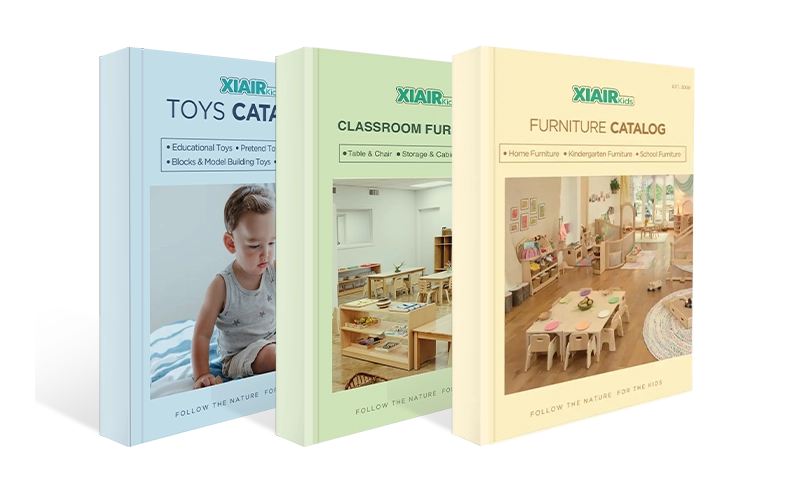
Receive a free catalog and custom layout to help you design your ideal classroom easily.
When to Choose Solid Wood vs. Engineered Wood
Sometimes both materials are appropriate depending on the function.
Choose solid wood when:
- The furniture experiences heavy load or climbing (tables, chairs, benches).
- You want long-term durability with the ability to refinish.
- Natural grain and aesthetics are a priority.
Choose engineered wood when:
- You need lightweight shelves or large storage units.
- Budget is limited but you still require stable, warp-resistant panels.
- You need surfaces that are easy to clean and maintain.
Frequently Asked Questions About Wood Types for Kindergarten Furniture
1. Which wood is best for making kindergarten furniture?
The best wood depends on where the furniture will be used.
Indoor: Maple, Beech, Ash, and high-quality Birch Plywood provide excellent durability, smooth finishes, and long-term stability.
Outdoor: Balau, Accoya, and Iroko perform best due to their resistance to moisture, insects, and temperature changes.
2. Which wood is the most cost-effective for kindergarten furniture?
For indoor furniture, Pine and Hemlock offer the best balance of affordability and performance.
For outdoor spaces, Cedar and Larch are cost-effective options with natural moisture resistance.
3. How can I tell if my kindergarten furniture is made from real solid wood?
Look for grain patterns that continue across edges and surfaces.
Check for natural variations in color and grain instead of a uniform printed pattern.
End grain should be visible on corners or cuts.
Solid wood usually feels heavier than MDF or other engineered panels.
4. Is hardwood always better than softwood for kindergarten use?
No. Hardwoods like Maple and Beech work well for high-stress indoor furniture, but softwoods like Cedar and Larch offer better moisture resistance for outdoor or semi-outdoor areas.
The best choice always depends on the intended use.
5. Which wood is best for outdoor kindergarten furniture?
Balau, Accoya, and Iroko provide excellent performance outdoors due to their ability to withstand moisture, UV exposure, and temperature changes.
Cedar is a good option for shaded or semi-outdoor areas.
6. What is the difference between engineered wood and solid wood?
Solid wood is cut directly from the tree and shows natural grain, strength, and character.
Engineered wood such as plywood, MDF, and laminated boards is made from layers or fibers for enhanced stability and cost efficiency.
Birch Plywood is often stronger and more stable than many solid woods, making it ideal for shelves and large panels.
7. How do I maintain and clean wooden kindergarten furniture?
Use a soft cloth and mild, child-safe cleaner.
Avoid soaking wood with water or using harsh chemicals.
Reapply protective coatings periodically if the furniture experiences heavy use.
Keep furniture in well-ventilated areas to minimize moisture damage.
8. How can I extend the lifespan of Cedar or other softwoods in kindergarten spaces?
Apply a protective outdoor-rated finish or oil to reduce UV fading and moisture absorption.
Keep the furniture in covered areas whenever possible.
Inspect joints and screws regularly since softwoods compress more easily.
9. Which wood is the most durable for kindergarten furniture?
For indoor use, Maple and Beech are the most durable choices thanks to their hardness and stability.
For outdoor use, Balau and Accoya deliver exceptional performance under harsh conditions.

